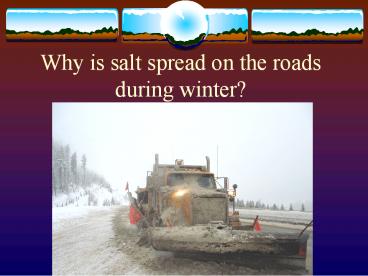Why is salt spread on the roads during winter? - PowerPoint PPT Presentation
1 / 31
Title:
Why is salt spread on the roads during winter?
Description:
Why is salt spread on the roads during winter? * Ch 18 Solutions Properties of Solutions Concentrations of Solutions Colligative Properties of Solutions Calculations ... – PowerPoint PPT presentation
Number of Views:85
Avg rating:3.0/5.0
Title: Why is salt spread on the roads during winter?
1
Why is salt spread on the roads during winter?
2
Ch 18 Solutions
- Properties of Solutions
- Concentrations of Solutions
- Colligative Properties of Solutions
- Calculations Involving Colligative Properties
3
Ch 18.1 Properties of Solutions
- Solution Formation
- Solubility
- Factors Affecting Solubility
4
Solution Formation
- What is a solution?
- A homogeneous mixture
5
Solution Formation
- What factors affect the formation rate of a
solution? - Stirring (Agitation)
- Temperature
- Surface Area Particle Size
6
(No Transcript)
7
Solubility
- Open to table G of your reference table
- The amount of solute that can dissolve in a given
amount of solvent
8
Types Of Solutions
- Saturated contains the maximum amount of a
solute in a given solvent - Unsaturated contains less solute than it has
the capacity to dissolve - Supersaturated contains more than the maximum
amount of a solute in a given solvent
9
Miscible
- Two liquids are completely soluble in each other
in all proportions
10
Factors Affecting Solubility
- Temperature solubility usually increases as
temperature increases - Gases are more soluble in cold water than in hot
water
11
Factors Affecting Solubility
- Pressure gas solubility increases as pressure
increases
12
Chapter 18.2
- How do you determine the concentration of a
solute in a solvent?
13
Molarity
- Molarity (M) moles of solute
- liters of solution
14
Concentration
- Measure of the amount of solute dissolved in a
given quantity of solvent - Dilute (low concentration) vs. Concentrated (High
concentration)
15
Making Dilutions
- Increase the amount of solvent, but keep the
amount of solute the same - M1 x V1 M2 x V2
16
Making Dilutions
- How many mL of stock solution of 2.00M MgSO4
would you need to prepare 100.0mL of 0.400M
MgSO4? - M1 x V1 M2 x V2
- 2.00M x V1 0.400M x 100.0mL
- V1 20.0mL
- So add 20.0mL stock solution and 80mL of water to
make 100mL
17
Percent Solutions
- Percent by Volume Volume of Solute x 100
- Solution Volume
- Percent (mass/volume) mass of solute (g) x100
- solution volume (mL)
18
Chapter 18.3 Colligative Properties of Solutions
- Decrease in Vapor Pressure
- Boiling Point Elevation
- Freezing Point Depression
19
Colligative Properties
- Properties that depend only on the number of
particles dissolved in a given mass of solvent
20
Vapor Pressure
- Vapor Pressure pressure exerted by a vapor that
is in dynamic equilibrium with its liquid in a
closed system
21
Decrease in Vapor Pressure
- A solution with a solute that is not easily
vaporized (nonvolatile) will always have a vapor
pressure lower than that of a pure solvent - The more solute particles dissolved, that more
the vapor pressure is lowered
22
Boiling Point Elevation
- When a solute is added to a solvent, the vapor
pressure decreases. Therefore more KE is needed
to turn the liquid into a gas. - The Boiling Point will be higher
23
Freezing Point Depression
- When a substance freezes, the particles form an
orderly pattern. - The presence of a solute disrupts the formation
of the orderly pattern - The more dissolved particles, the lower the
freezing point
24
Chapter 18.4 Calculations
- Molality and Mole Fraction
- Boiling Point Depression and Freezing Point
Depression - Molar Mass
25
Molality
- Molality moles of solute
- kilogram of solvent
- 1000g of water 1000mL
26
Mole Fraction
27
Boiling Point Elevation
- ?Tb Kb m
- ?Tb change in boiling point temperature
- Kb molal boiling point elevation constant
(oC/m) - m molality
- For ionics multiply the number of ions formed
times the m
28
Freezing Point Depression
- ?Tf Kf m
- ?Tf change in freezing point temperature
- Kf molal freezing point depression constant
(oC/m) - m molality
- For ionics multiply the number of ions formed
times the m
29
(No Transcript)
30
(No Transcript)
31
(No Transcript)































